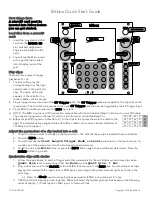
PF-1000
152
Troubleshooting
Problem
Possible Cause and Solution
•
The PF-1000 does not turn on; there is no
power.
Make sure that the PF-1000 has been plugged in properly. Securely insert the
female plug into the AC socket on the PF-1000, and the male plug into a proper
•
A click or pop is heard when the power is
turned on or off.
This is normal when electrical current is applied to the instrument.
•
Noise is heard from the PF-1000’s speakers.
Using a mobile phone in close proximity to the PF-1000 may produce
interference. To prevent this, turn off the mobile phone, or use it further away from
the PF-1000.
•
The display is too bright or too dark to read.
The brightness of the display may be affected by the surrounding temperature;
try adjusting the contrast (page 17).
•
The keyboard volume is low compared to that
of the Auto Accompaniment or song playback.
The overall keyboard volume or the independent volume level of the keyboard
part may be set too low. Raise the MAIN/LAYER/LEFT volume voices or lower
the STYLE/SONG volume in the BALANCE display (page 61).
•
The volume of the Auto Accompaniment or
song playback is low compared to that of the
keyboard.
The volume level of one or more accompaniment parts or song channels is set
too low. Raise the part or channel level(s) in the appropriate MIXER display
•
The overall volume is low, or no sound is
heard.
•
The Master Volume is set too low; set it to an appropriate level with the
[MASTER VOLUME] dial.
•
The volume of the individual parts may be set too low. Raise the volume of
MAIN, LAYER, LEFT, STYLE, and SONG in the BALANCE display (page 61).
•
Make sure the desired channel is set to ON (page 61, 76).
•
Headphones are connected, disabling the speaker output. (This happens
when the speaker setting is set to “HEADPHONE SW”; page 138.) Unplug the
headphones.
•
Make sure the speaker setting is set to ON (page 138).
•
Make sure the Local Control function is set to ON (page 134).
•
The damper, sostenuto and soft functions do
not work for the relevant pedals.
Each pedal has been assigned to a different function. Make sure that each pedal
is properly assigned to SUSTAIN, SOSTENUTO, and SOFT (page 128).
•
The damper pedal has no effect, or the sound
continuously sustains even when the damper
pedal is not pressed.
The pedal cable/plug may not be properly connected. Make sure to securely
insert the pedal plug into the proper jack (page 150 - 151).
•
Not all simultaneously-played notes sound.
You may be exceeding the maximum polyphony of the PF-1000. When this
happens, the earliest played notes will stop sounding, letting the latest played
notes sound. See page 154 for information on the maximum polyphony.
•
Accompaniment style or Song playback does
not start.
•
MIDI Clock may be set to “EXTERNAL.” Make sure this is set to “INTERNAL”
•
Make sure to press the appropriate [START/STOP] button. To play an
accompaniment style, press the
STYLE CONTROL
[START/STOP] button
(page 61); to playback a song, press the
SONG
[START/STOP] button
•
“New Song” (a blank song) has been selected. Make sure to select an
appropriate song in the SONG display (page 74).
•
The song has been stopped at the end of the song data. Return to the
beginning of the song by pressing the [TOP] button (page 76).
•
Only the rhythm channel plays.
Make sure the Auto Accompaniment function is turned on; press the [ACMP] button.
•
The accompaniment style does not start,
even when Synchro Start is in standby
condition and a key is pressed.
You may be trying to start accompaniment by playing a key in the right hand
range of the keyboard. Make sure to play a key in the left-hand (accompaniment)
range of the keyboard.
•
The desired chord is not recognized or output
by the auto accompaniment.
•
You may not be playing the correct keys to indicate the chord. Refer to “Chord
Types Recognized in the Fingered Mode” (page 63).
•
You may be playing the keys according to a different fingering mode, and not
the one currently selected. Check the accompaniment mode, and play the
keys according to the selected mode (page 62).







































